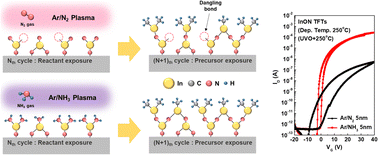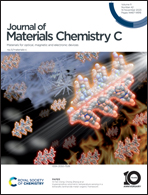Tailoring thin film transistor performance through plasma reactant manipulation in indium oxynitride films†
Abstract
Metal oxynitride semiconductors have attracted considerable attention as promising alternatives to oxide semiconductors for diverse display applications owing to their superior electrical performances. However, the fabrication of oxynitrides is still challenged by the low stability of metal–nitride bonding which results in facile oxidation. In this study, indium oxynitride (InON) thin films grown by plasma-enhanced atomic layer deposition using nitrogen (N2) and ammonia (NH3) as different nitrogen reactant plasma sources were firstly demonstrated. We suggest that their different reaction mechanisms which include a discussion of dangling bonds result in the differences in In–N bonding and oxygen-deficient states. In NH3-fabricated InON thin films, the proportional content of oxygen atoms and anion-related defects is reduced compared to N2-fabricated InON, which leads to a decrease in the optical bandgap and an increase in electrical characteristics. Also, we identified that PEALD-fabricated InON has reasonable In–N stability for an ambient and thermal budget (250 °C, UV-ozone, 1 h). Fabricated thin film transistors using InON exhibit highly improved device properties when NH3 is used (μeff = 24.99 cm2 V−1 s−1) compared to N2 (0.23 cm2 V−1 s−1) which corresponds well with the suggested fabrication mechanisms and film properties.



 Please wait while we load your content...
Please wait while we load your content...